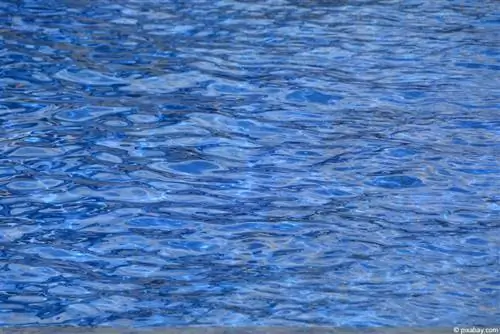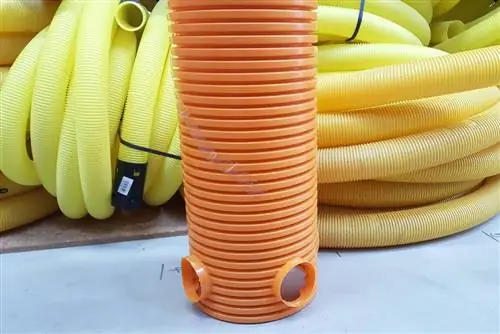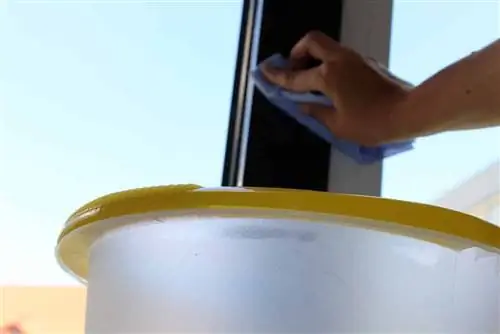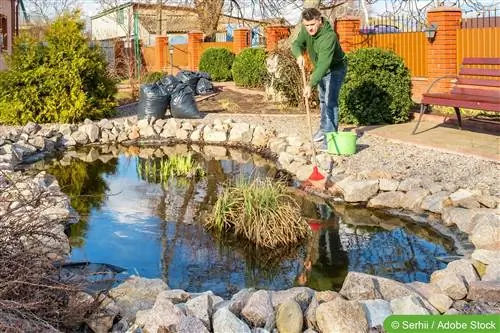- Author admin [email protected].
- Public 2023-12-17 03:39.
- Last modified 2025-01-24 12:45.
Cleaning patio tiles is actually quite easy. However, means and methods should be tailored to the material so that the tiles are thoroughly cleaned but the material is not damaged. Wood, for example, needs to be treated differently than stone or ceramic tiles. Interested readers can find out here whether high-pressure cleaners or scrubbers are the right choice for cleaning tiles in the garden.
Preparation
No matter whether the terrace tiles are made of wood or stone, the terrace must be prepared accordingly before thorough cleaning. These include the following points:
- Clear the terrace
- remove coarse dirt such as leaves, branches and twigs
- Remove weeds from the joints with a joint scraper
- Pretreat green coverings, such as moss and lichen
- Check tiles for damage and weak points
Soda has proven effective for pre-treating moss and lichens. Ideally, washing soda is used directly. Dissolved in water, it is applied generously to the affected areas and left to act for about an hour. The tiles can then be scrubbed and rinsed.
Stone and ceramic tiles
Patio tiles made of stone and ceramic are quite easy to clean. They can be cleaned very easily with a high-pressure cleaner and pure water. However, cracks in the tiles and cracks in the joints can be problematic when cleaning with high pressure. The water can increase the damage. Therefore, as mentioned, it is important to check the tiles in advance.
Damaged areas should be cleaned by hand and without high pressure and then repaired. If it is very dirty, it can also help to pre-treat the patio tiles with soft soap or dishwashing liquid before using the high-pressure cleaner. This loosens the dirt and makes it easier to remove afterwards.
Tip:
If you only use the high-pressure cleaner to clean the terrace, you don't have to buy such a device yourself. Many hardware stores also rent them for a small fee.
Wood tiles
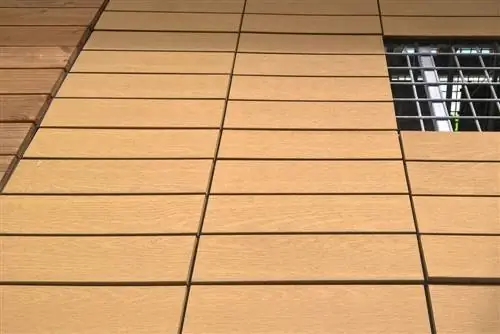
Patio tiles made of wood are more sensitive to targeted and selective pressure. Unnoticed cracks in the wood can cause individual parts to come off during high-pressure cleaning. Connection points and wood glue can come loose. It is therefore not recommended to use a high-pressure cleaner.
The simple option is to clean with soft soap, water and a scrubber. A hand brush can also be used for tighter areas. As simple as this method is, it is also very strenuous. An alternative to this is an electric scrubber. With this and by pre-treating with soda or soft soap, cleaning the wooden tiles becomes much easier and the effort is reduced.
Click tiles made of wood and plastic
Patio tiles with a click system made of plastic and a support made of wood or plastic have many advantages. They are comparatively inexpensive, can be laid quickly and easily and can be removed from the terrace or balcony just as easily and quickly if necessary. If necessary, individual tiles can also be replaced.
Advantage
When cleaning the terrace with click tiles, these properties and the combination of materials result in both advantages and disadvantages. On the one hand, large amounts of dirt accumulate in the joints and under the tiles. Experience has shown that leaves, soil, pebbles and dead plant parts appear in large quantities when the click tiles are removed. For a really thorough pre-cleaning, it is not enough to just sweep the terrace tiles. The joints should be vacuumed. It will be even more thorough and cleaner if the tiles are clicked apart directly and the surface is cleaned separately.
Disadvantage
On the other hand, the plastic click system becomes brittle and brittle over time, which could cause damage during high-pressure cleaning. The same applies to the comparatively thin wooden slats that are screwed onto the plastic. Although these are resistant to distributed pressure, they can crack and tear under targeted high pressure.
Cleaning
It is therefore better to clean the click tiles on the terrace or balcony as follows:
- The tiles are separated from each other and are already roughly cleaned of dirt.
- The surface is cleaned of coarse impurities such as leaves, twigs and soil with a broom. It can then be cleaned with a scrubber or a high-pressure cleaner.
- The click tiles themselves are first brushed dry. A correspondingly thick bottle brush is recommended for grooves and joints.
- Once all dry and coarse dirt has been removed, the tiles can be wet brushed or scrubbed. A mixture of soft soap, dissolved washing soda or dishwashing liquid and water is recommended as a cleaning solution.
- To prevent the terrace tiles from becoming stained by the cleaning agent, they should then be rinsed well with clean water.
- The tiles can be set up to dry or laid out again straight away.
Aftercare
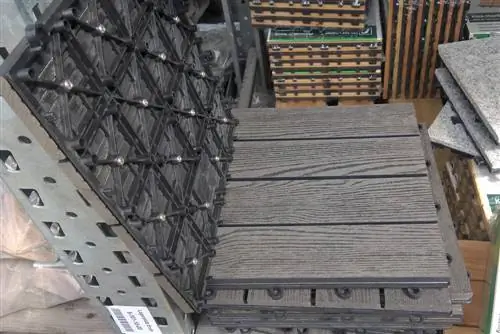
After cleaning the terrace tiles and when they have completely dried again, the ideal time has come for any necessary follow-up treatment. Once the tiles have been grouted, cracked joints and cracks can be repaired if necessary. A sealant can be applied to stone tiles that has a dirt-repellent effect.
Wood preservatives can be used for wooden tiles, which protect the natural material from moisture penetration and the resulting frost damage, reduce the risk of cracks and also prevent warping and bending of the wood.


